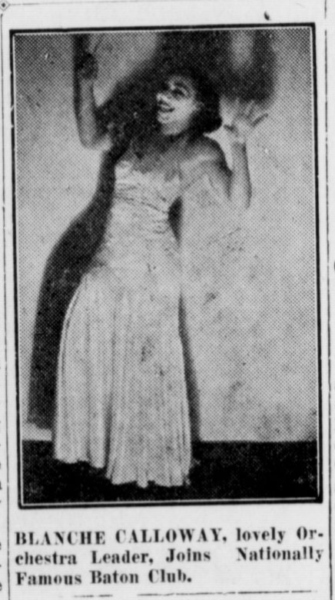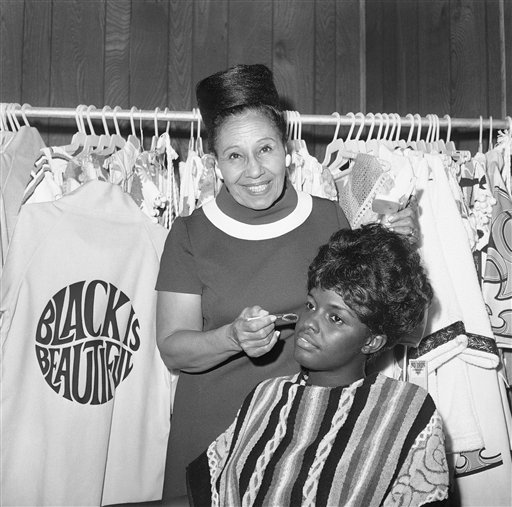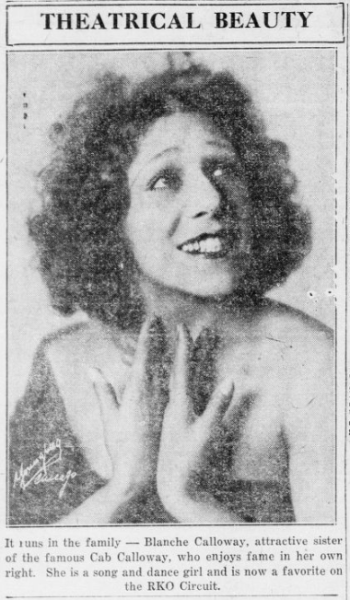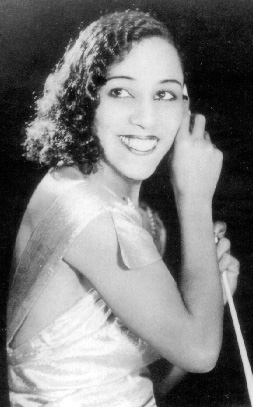When I tried out for band at the end of my fourth grade year, I wanted to play the trumpet or the flute, but the highschool band counselor they had brought in to help us choose our instruments said my mouth was all wrong for those. They recommended the clarinet, and, after a short period of normal child disappointment, I embraced my instrument. Through learning the clarinet I found Swing, Big Band, and the ‘Hot’ Jazz of the early 1900s. I wanted to play like Benny Goodman or Artie Shaw. The lingering feelings of my youth still lead me down roads of early jazz history. Recently, I had the opportunity to explore my library’s African American Sheet Music collection while creating an exhibit called Swing Along! But, other than the torch singers whose music I collected, I didn’t see many women. I am looking for them now, and want to …
Celebrate Blanche Calloway

The Detroit tribune. (Detroit, Mich.), 29 Feb. 1936. Chronicling America: Historic American Newspapers. Lib. of Congress. <https://chroniclingamerica.loc.gov/lccn/sn92063852/1936-02-29/ed-1/seq-6/> 
Evening star. [volume] (Washington, D.C.), 02 June 1936. Chronicling America: Historic American Newspapers. Lib. of Congress. <https://chroniclingamerica.loc.gov/lccn/sn83045462/1936-06-02/ed-1/seq-38/> 
Blanche Calloway, sister of band leader Cab Calloway, demonstrates how to apply cosmetics made especially for black people in Miami, Florida on July 30, 1969. Her Miami business bas boomed from a small firm to a growing national market in less than a year. The model is Sylvia Dobson. (AP Photo/JPK) 
Richmond planet. [volume] (Richmond, Va.), 22 Nov. 1930. Chronicling America: Historic American Newspapers. Lib. of Congress. <https://chroniclingamerica.loc.gov/lccn/sn84025841/1930-11-22/ed-1/seq-16/> 
By Source, Fair use, https://en.wikipedia.org/w/index.php?curid=34208796
Blanche Calloway was a flamboyant performer, singer, dancer, business woman, and the first woman to lead an all male orchestra. She is relentlessly written about as residing in the shadow of her younger brother Cab Calloway. However, scholars and researchers have pointed out that, at one point, Blanche Calloway had attained more fame and renown, helping her brother in his show business breakthrough and inspiring his famous style (Wikipedia; Handy, 1998)
Calloway was born in 1902 or 1903 into an upper middle class African American family in Baltimore. Her father was a lawyer and her mother was a music teacher. Even though Calloway’s mother pressed her into piano and vocal lessons, she may not have wholly supported Calloway’s musical career when Calloway dropped out of Morgan State College to join a cabaret troupe. She gained some notoriety in 1920s Chicago, appearing in Sissle and Blake’s “Shuffle Along,” dancing at Chicago and New York clubs, and touring with “Plantation Days” (Sonny Walton; Jazz Rhythm).
After “Plantation Days,” Calloway stayed in Chicago, performing at the Sunset, later touring nationally on her own and fronting Andy Kirk’s orchestra. It was with Andy Kirk that Calloway decided she wanted to lead her own band, first called ‘Her Joy Boys’ and then later ‘Her Orchestra.’ Calloway and her band performed at New York City’s Lafayette Theatre, Harlem Opera House, the Apollo Theatre, and toured nationally.
Bad luck befell Calloway on one of these national tours. While stopping at a Shell gas station in Yazoo City, Mississippi, in 1936, Calloway and the wife of one of her orchestra used a restroom marked simply ‘ladies,’ not realizing that segregation laws in Mississippi meant that ‘ladies’ rooms were strictly for white women, and separate ‘colored women’s’ restrooms were not always available (Tucker, 2000). The two women had crossed the street to a nearby cafe by the time the police car showed up. Instead, the officer approached Norman Pinder, Calloway’s husband, and demanded to know where the two women had gone. When Mr. Pinder didn’t hear the officer correctly and asked for clarification he was struck repeatedly by the butt of a revolver. Pinder, Calloway, and her companion where arrested and held in jail. The deplorable incident made national news and resulted in letters of protest from the NAACP, letters of apology from Shell petroleum company headquarters in New York, and a boycott of Shell gas stations by African Americans (Dayton forum).
While in jail a member of Calloway’s orchestra absconded with the group’s money. The Orchestra disbanded after this and Calloway had to sell her yellow Cadillac for money to leave the state. Calloway was ultimately unable to financially recover from this loss and filed for bankruptcy in 1938. At some point after declaring bankruptcy, Calloway and her husband ended their marriage. Calloway organized a short lived all female band in 1940, when WWII created an interest and foot hold for all female groups; then moved to Washington DC where she managed a club called Crystal Cavern. It was here where Ruth Brown, who would later become the Queen of R&B, met Calloway. Calloway would support Brown’s early career much the same as she had done for her younger brother.
By 1943 Calloway was again in the news and in court, this time as an unwitting and innocent third party to her second husband’s bigamy. Hilloray Ray Jones, who worked as a dining car waiter, had wooed and won Calloway after leaving his first wife in Chicago. Mrs. Jones had sued for financial support and was granted it by a court. It is for default of this that Hilloray Jones was summoned to court when he and Calloway had returned to Chicago to attend his sister’s funeral. He protested that he had never been married, but his first marriage was proved in court by witnesses. Jones was fined and jailed. A reporter for the Chicago Defender witnessed Calloway kiss him and bid him goodbye at the end the end of the proceedings. It is unclear whether this was a final goodbye.
Blanche Calloway lived for a time in Philadelphia, becoming active in community and political affairs, before moving to Miami Florida in the 50s. In Florida she became the only African American woman disc jockey and later executive director for WMBM. She was the first African American precinct voting clerk and the first African American woman to vote in the State of Florida in 1958. She became a member of the NAACP, the Congress of Racial Equality (CORE), and served on the board of the National Urban league. In 1960 Calloway accompanied A.D. Moore, the chairman of CORE, in his test of the newly desegregated lunch counter of Grant’s Store after months of sit-ins. In 1964 she and other African American women protested with the NATO Women’s Peace Force at the Hague (Wikipedia).
In 1968 she formed Afram House, a mail order cosmetics company, in order to provide African American women with cosmetics, wigs, and accessories designed for a darker skin tone. The company was expanding into real-estate by 1970s, with plans to open a chain of stores. During this time of civil rights activism and business acumen, Calloway was fighting breast cancer, crediting Christian Science with helping her during her 12 year battle. During the last years of her life, she moved back to Baltimore, and married her high school sweetheart.
Blanche Calloway lived a lifetime of firsts, always at the forefront of change and innovation in entertainment, business, and social reform. She was a powerful woman who propelled others forward. Both her brother, Cab Calloway, and her protege, Ruth Brown, attribute Blanche Calloway with playing a key roll in their early careers. You can find more of Blanche Calloway’s songs on the Internet Archive: https://archive.org/search.php?query=blanche%20calloway.
I mentioned last month that it was a shame we restrict our appreciation of underrepresented citizens to one month a year. In this spirit, I am turning my attention to a new series dedicated to the stories that would usually only pop up during African American History Month, Women’s History Month, LGBTQ+ History Month, and Native American Heritage Month, #EveryMonthIs__HistoryMonth.
References
- Afram’s cosmetic consultants. (1970, Jan 03). Sun Reporter (1968-1979)
- Blanche Calloway (n.d.) Jazz Rhythm. http://jazzhotbigstep.com/789221.html
- Blanche Calloway (2019) Wikipedia. https://en.wikipedia.org/wiki/Blanche_Calloway
- Blanche Calloway Jones. (1979). The Black Perspective in Music, 7(2), 281.
- Blanche Calloway Hubby May Face Bigamy Charge. The Chicago Defender (National edition) (1921-1967); Dec 4, 1943; pg. 13
- Blanche Calloway’s Hubby Held In Contempt By Court The Chicago Defender (National edition) (1921-1967); Dec 11, 1943; pg. 13
- The Dayton forum. [volume] (Dayton, Ohio), 25 June 1937. Chronicling America: Historic American Newspapers. Lib. of Congress. https://chroniclingamerica.loc.gov/lccn/sn84024234/1937-06-25/ed-1/seq-4/
- The Detroit tribune. (Detroit, Mich.), 13 Aug. 1960. Chronicling America: Historic American Newspapers. Lib. of Congress. https://chroniclingamerica.loc.gov/lccn/sn92063852/1960-08-13/ed-1/seq-1/
- Gulla, Bob (2008) Icons of R&B and Soul: An Encyclopedia of the Artists Who Revolutionized Rhythm [2 Volumes] : An Encyclopedia of the Artists Who Revolutionized Rhythm
- Handy, Antoinette (1998) Black Women in American Bands and Orchestras. Lanham, Md : Scarecrow Press
- Sherrie Tucker. (2000). Swing Shift : “All-Girl” Bands of the 1940s. Duke University Press Books.
- Sonny Walton’s Street Swing. Blanche Calloway. https://www.streetswing.com/histmai2/d2blnch1.htm
